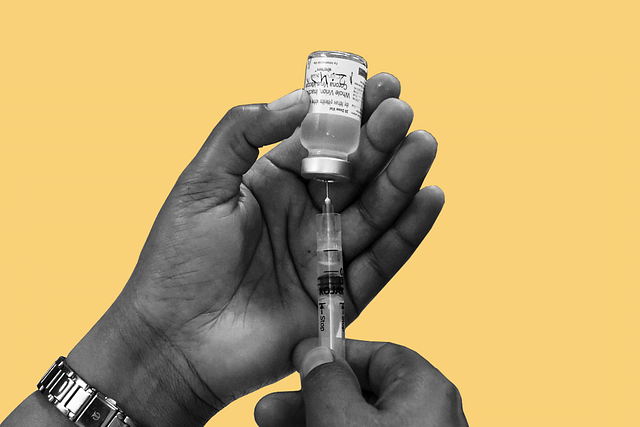
Vaccinomics 1.0: There Is No Free Lunch Even When It Comes To Life-Savers
You cannot have a vaccine policy that is built on the assumption that producers can make endless losses in the interests of public health.
Only governments can do that, and even they cannot do so forever, since fiscal capacities are limited in both Centre and states.
It is only when things go wrong, or when they seem to go wrong, that we get the real picture.
This is clearly the case with our vaccine strategy. We adopted the slow and steady approach to vaccinating the population – first healthcare workers, then frontline workers and then the above-60s and above-45s – for the same reason why we adopted the hard lockdowns approach last year. The government needed time to work out the best way forward. It’s the same this time.
One can surmise that the government needed time to figure out what was the best way to vaccinate the population because it knew that the real costs of vaccinating a larger number of persons (or all above the age of 18, as now decided) was going to be very high and unaffordable. And this, at a time when overall infection rates were falling consistently, seemed like a reasonable risk to take.
Newspapers on Thursday (22 April) revealed the pricing strategies of India’s biggest vaccine maker, Serum Institute of India, post 1 May, and we know the reality now.
According to Serum Institute’s Adar Poonawala, the price of Rs 150 per dose paid by the Centre was grossly unviable. Of this amount, half had to be paid as royalty to AstraZeneca, making Serum entitled to only Rs 75 a jab – or barely $1 against prices of $10-20 for various international vaccines from Pfizer, Moderna or even the yet-to-be-launched Sputnik-V from Russia.
Serum has now announced prices of Rs 400 for state buyers in bulk, and Rs 600 for hospitals and other private sector vaccinators.
You cannot have a vaccine policy that is built on the assumption that producers can make endless losses in the interests of public health. Only governments can do that, and even they cannot do so forever, since fiscal capacities are limited in both Centre and states.
Consider just a few sums.
At the totally uneconomical price of Rs 150 a jab, which means Rs 300 for two jabs, vaccinating a million people costs Rs 30 crore. Vaccinating the entire cohort of 18-plus – probably around 750-800 million adults – would cost a staggering Rs 24,000 crore. It would have inflicted enormous losses on Serum and other vaccine makers.
At the more economic price of Rs 400, which apply from 1 May, inoculating 800 million people can cost Rs 64,000 crore. And remember, this is just the first phase and more may be needed if we have third and fourth waves of Covid, not to speak of mutant strains that demand even higher potency vaccines that need more research and more investments.
This explains the Centre’s slow and steady approach to vaccinations.
One, it allowed the government time to evaluate how the vaccines work, and whether everyone needed to be vaccinated or not. We now know that vaccinating larger numbers is unavoidable, but we could not have known it in January when the decision was taken.
Two, the Centre already knew that paying just Rs 75 to Serum Institute was simply not workable, leave alone scalable. There is no way Serum would have expanded capacity just to make higher losses. Expanding vaccinations slowly would have enabled the Centre to not only allow dual pricing in order to cross-subsidise vaccines for the poor, but also gave it time to allow new vaccine makers to compete for orders and bring down overall costs at higher volumes.
Three, the go-ahead for Covaxin in January was probably prompted by the same logic. It was intended to make sure that Serum would not be a monopoly, while also keeping royalty costs low. Bharat Biotech does not have to pay any extortionate royalties since its vaccine was supported by government labs and the Indian Council for Medical Research. Expanding vaccinations slowly also allows Serum Institute, and other vaccine makers, to produce newer vaccines without the AstraZeneca royalty structures.
The bottomline is this: the super-fast revival of Covid 2.0 has scuppered the Centre’s strategy, forcing it to reckon with higher prices to meet demand and finance capacity expansion. If the Covid wave had waited till, say, September-December 2021, India would have been better prepared to vaccinate many more and faster.
The two realities we now are confronted with are simple:
First, any plan can go awry without adequate back-ups. But creating back-ups has a cost, just as hoarding and stockpiling of any commodity has costs. You can buy crude when prices were $30 a barrel, but you lose if prices fall further, or have to hold inventories for longer.
Two, it never pays to over-regulate prices, for sooner than later it damages the country’s ability to ramp up production by short-changing producers. Anything free also engenders irresponsibility, as we are finding out. All non-Bharatiya Janata Party states have kicked up a fuss over Serum’s prices after yelling blue murder about vaccine shortages and demanding that everyone be vaccinated.
Now they can do so by putting their money where their mouth is. But knowing Indian politicians, they will now demand that the Centre subsidise them so that they can claim credit for cheap vaccines. Irresponsibility rules as long as governments are not confronted with market realities.